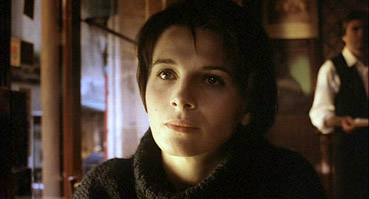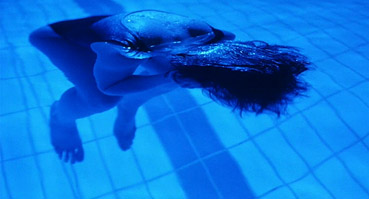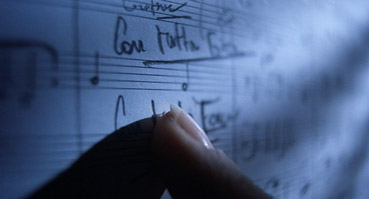|
If you've never heard of Krzysztof Kieslowski and his Three Colours trilogy then I can only assume you're new to the very concept of world cinema. If you've never seen the trilogy then there is a serious hole in your film education and appreciation. There are sound reasons why Kieslowski is regarded as a giant of cinema, a position earned on the back of only a handful of films in the final years of a career that includes 40 directing credits. That's not to dismiss the earlier work in any way, but it was the international impact of the later films that prompted most serious film enthusiasts to learn how to spell one of the trickier first names in modern cinema. And here's a guess – if you've seen the first Three Colours film then it's almost a given that you've seen the other two as well. It's not a matter of continuation, as the stories and characters of the three films are independent of each other. But Blue is such an extraordinary work that having seen this one you'll want – at least I'd hope with all my heart you would – to see the others as soon as you can lay your hands on them.
The problem with retrospectively approaching a film like Three Colours: Blue is that is that it has been written about and analysed to such a degree that any new review is inevitably going to recycle the words of others, and I've not read any thing like all of the essays written on the film and its director. For admirers this may thus prove a redundant essay, and to be honest is only being written at all because of the film's inclusion in the recently released three-DVD set The French Collection, Vol. 1: Juliette Binoche from Artificial Eye. My target audience, like that of a DVD set that only includes the first of the trilogy, is those who really are new to the film and its director. If that includes you then in a way I am envious, as you have a number of memorable first viewings ahead of you. If you are going to watch all three films then I'd also recommend seeing The Double Life of Veronique, and not just because it's a gloriously beautiful film – there are definite thematic and stylistic similarities to the trilogy.

Right, a few notes for the newcomers. The film in the Three Colours trilogy are, in order, Three Colours: Blue [Trois couleurs: Bleu] (1993), Three Colours: White [Trzy kolory: Bialy / Trois couleurs: Blanc] (1994) and Three Colours: Red [Trois couleurs: Rouge] (1994). Red was to prove Kieslowski's final film – he announced his retirement from filmmaking after the film premiered at Cannes in 1994, and died of a heart attack two years later. The trilogy was inspired by the colours of the French flag and the motto of the French republic, "Liberté, égalité, fraternité" (liberty, equality and brotherhood), the aim being to produce the films in the order of the colours on the flag, with the words of the motto providing the thematic base.
Blue deals with liberty, but if this creates expectations of a film about a literal struggle for freedom against oppression then you really don't know Kieslowski. The liberty in question is initially imposed by fate on Julie Vignon when she survives a car crash which results in the death of her young daughter and her husband, a nationally celebrated composer. Following a long recovery, she embraces liberty of a different sort. After coldly sleeping with her husband's friend and fellow composer Olivier, a man who has for a long time been in love with Julie, she puts their house up for sale and completely withdraws from her previous life, renting an apartment in Paris under her maiden name and having almost no direct contact with anyone from her past. "I don't want any belongings, any memories," she tells her mother, who lives in a home and is no longer able to differentiate reality from the television to which she is glued, "No friends, no love. Those are all traps." What she is unable to put completely behind her is her husband's music, which in moments of strong emotion overwhelms her reality and triggers a strong emotional connection to the colour blue.
That Julie will gradually rediscover her humanity is almost inevitable, but that's about the only thing you can risk taking for granted here. Expectations that her husband's unfinished composition for the Unification of Europe might come to public light are initially dashed when Julie destroys what she believes is the only copy, but it is the music that proves a key aspect of her recovery, the one part of her life that still has the power to prompt an emotional response. Her cold exterior is occasionally revealed to be a fragile state, powerfully communicated when she drags her knuckles along a stone wall in order that she might feel something, even if it be pain (as fans of the film will know, circumstances led to Binoche doing this for real and wearing the scars for a year).
While this sort of emotional journey far from unique in European cinema, what makes Three Colours: Blue such a mesmerising experience is its handling, and herein lies the reason for Kieslowski's formidable reputation. Blue achieves the rare feat of boasting an astonishing visual and aural beauty that never for a second feels superfluous or decorative. Every gorgeously composed shot, every line of dialogue, every note of music has narrative and character purpose, and yet all are exquisite in their own right. Key information is provided in minimalist fashion through some striking camera placement and editing, and though while are very few actual POV shots, the action is often observed specifically from Julie's emotional viewpoint, the use of colour and huge close-ups showing us the world as she sees it without actually looking directly through her eyes.

The marriage of sound and image is hypnotic throughout, the orchestral mid-scene fades to black having a power that on paper should be lost to overstatement. The stunning close-up that follows Julie's finger as it traces the score sheet, seemingly prompting the music itself to explode onto the soundtrack and changing with each of Julie's suggested modifications, may qualify as one of the most cinema's most perfectly realised examples of picture and sound in absolute harmony.
But for all its technical beauty, Blue's emotional power – and this it has in abundance – works primarily through its central performance, a low-key tour-de-force from the superb Juliette Binoche, who is required for much of the film to convey her inner feelings while in a self-imposed state of emotional shut-down and solitude. When the emotions do surface they are painfully real (the scene in which she watches the funeral of her husband and daughter on a portable TV in her hospital bed carries considerable emotional clout, despite occurring less than ten minutes into the story) and are never overplayed. It's Binoche that for some makes Blue their favourite of the trilogy, and in a career that's included a number of memorable and award-winning performances, this, for me at least, remains one of her very finest.
I've done my sell, maybe overdone it, that's your call. But my purpose is singular – if for some reason you've never seen Three Colours: Blue then make a new year's resolution to do so, and stick to it. Yes, it's in French and no, it's not one of those upbeat films you may sit and watch with the kids and an intolerant partner. But that's a good thing. You shouldn't be making time to see film like Three Colours: Blue, but cancelling other arrangements to do so. Blue is a work of genuine cinematic beauty whose rewards for any true film enthusiast are many, a work that will enrich and expand your appreciation of cinema as a medium of emotional communication and artistic expression.
A solid anamorphic 1.85:1 transfer that handles well the film's use of various colour tints, with bright blue a notorious challenge for any video version. There is some visible grain that is very likely on the source print rather than of digital creation, but contrast, black levels and detail are always good and pleasingly free of obvious enhancement or compression noise.
The 5.1 surround track does the film proud. The late-career Kieslowski films all feature impressive sound mixes and Blue is no exception, with fine use made of the full sound stage for ambient sound and specific effects. The music, as is only right, sounds magnificent, a richness and bass that only 5.1 (or above, let's not get picky) can bring.
Krzysztof Kieslowski Masterclass (1994)
The man himself takes us through the scene in which Olivier approaches Julie in a café after tracking her down. Particularly fascinating is Kieslowski's minute attention to detail, illustrated in the close-up of a sugar cube soaking up coffee. Apparently they searched for some time to find a cube that would soak up the liquid in less than five seconds because, according to Kieslowski, "an audience can take four-and-a-half seconds of a sugar cube dissolving, eight and a half would be too long."

Juliet Binoche (23:05 total)
This is an audio-only interview with Juliet Binoche, broken into nine chapters (there is no 'play all' option) and accompanied by extracts from the film, some of which she directly comments on, making this more like a selected scene commentary track. It's all interesting and often illuminating, with information supplied on Kieslowski, director of photography Slawomir Idziak (who she describes as being like a brother to the director), her views on screen intimacy and nudity, the injury to her hand that she suffered during the knuckle-scraping sequence, and the character of Julie in general, including the work that influenced her interpretation of the role. Especially interesting is the news that she turned down the female lead in Jurassic Park to do Three Colours: Blue. "It would have been fun to work with Steven Spielberg," she tells us, but reasons that "Blue interested me more as a human being, as an actress," tellingly adding "I would have preferred to play a dinosaur rather than one of the human beings he wanted in the film."
Jacques Witta, editor (14:00 total)
A more conventional interview conducted by the same team as the one above, again divided into chapters and including extracts of the film. Inevitably, Witta discusses the film's structure and use of music, with Kieslowski coming in for particular praise as the filmmaker who "mastered editing more than any other director I've worked with." He talks about Kieslowski's collective method of working, the process of making the three films back to back, and suggests (something Camus will no doubt agree with) that the editor is the one major contributor to a feature film who doesn't get to make his mark, precisely because to do so would be disruptive to the storytelling.
Martin Karmitz, producer (16:23 total)
In a similar manner to the above, Karmitz talks about his first meeting with Kieslowski, the development of the trilogy, the filming and editing schedule, his role as producer, and the differences between working hours on French and Polish films. He finishes with an interesting anecdote about communication, one I have also had experience of under similarly alcohol-fuelled circumstances.
Extracts from the Original Soundtrack
On the main menu you can access three isolated extracts from Zbigniew Preisner's magnificent score, which are of the expected excellent quality. The third, Olivier and Julie – Trial Composition, includes the voices of the actors as they changes are suggested and implemented.
Trailers
Trailers are included for Three Colours: Blue (1:46), Three Colours: White (1:32) and Three Colours: Red (1:29).
I realise that there's a good chance that many of you will already have bagged this one, either as a stand-alone disc or as part of the Three Colours Trilogy box set, both of which have been available for some considerable time. If not, then both are still available and reasonably priced, given the extra features and the quality of the transfer. Now you also have a third option in Artificial Eye's first French Collection set. All are recommended – you just have to find the one that's right for you.
|